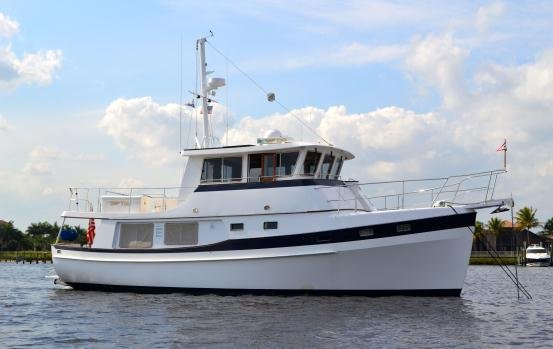Ok come on...

I can go to West Marine and 15 minutes and a thousand dollars or less later have a pretty nice anchor of any size sitting in the back of my trunk. An hour later it can be on my bow.
I didn't read this as a humorous statement, so if it was intended as a joke then you got me. If you meant this seriously, I think this is one of the most dangerous scenarios I've seen on this forum.
First of all, the suggested size Rocna for that Mckinna is 55, which is $1,660 at West Marine. But even if it were possible to simply swap out the SS plow on the McKinna and insert the Rocna, that would be hugely misguided.
Everything on that production boat was sized by the builder as a package. From the pulpit, roller, chain stopper, windlass, windlass wiring, chain, chain storage, better end fastening - everything was designed and sized to work together. I'm going to take a stab here and say it was designed with about 5,000 lbs holding power in ideal conditions. And if you fastened an anchor with 10K lbs holding power (again, ideal conditions) on the end, you still have an anchoring system with 5K holding power - but one that will put a larger load on every part of the system when retrieved and stowed than was originally designed.
So...let's add 3 shots of 1/2" G4 chain (WL 9,200 lbs) at a cost (from West Marine) of another $2,943. Now just that chain and anchor weigh approximately 450 lbs more than the existing setup - is that going to change the trim? Naw, it's all good.
Oh crap. The maximum chain size of the Maxwell VWC 2200 is 7/16". So let's bump that up to a new Maxwell VWC 3500 at $4,823 from WM. Will that work with the existing controls? Mounting holes? Let's assume yes. Will the deck withstand a 3500 lb pull up from 2500? Let's just wing it and say sure - I mean, what's the worst that can happen? I mean it's not like your life depends on this, right? Oh wait...
Well, we're all good now, right? New chain, anchor, windlass - I'll even throw in the windlass mounting. But we know there's no way in hell the Rocna is going to fit on that pulpit. Want to ballpark a revised pulpit roller? $2K? Everyone good with that? OK, we're now up to $11,426. Plus tax. Plus you have a (literal) ton of metal in your trunk. Are we done?
Um, no. The old windlass drew 71 amps, the new one draws 100 (assuming 12V - there's no mention of 24V anything in the McKinna listing). I'm too lazy to work out the voltage drop but I'm pretty sure the wiring is going to have to be upgraded. And the breaker.
Am I overthinking this? Maybe. But what's the real-life cost of UNDER-thinking this?
And this is just one anchor, no backup. Let's start talking about having anchors for two different bottom conditions. Or a spare rode. Or...

